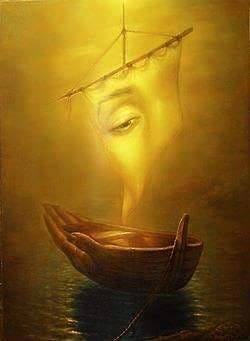On A Boat With No Oars
Thoughts on Grief, Faith & Co-Creating with The Mystery
Note: first published on April 2, 2025 in my email newsletter, The Hearth
As I sit and write, the view outside my window is a contrast of bright purple rosemary and lavender blooming, pink rock roses, birds flitting about . . . And wet heavy snowflakes coming down. Spring is the erratic end of Winter, and as the Artist Formerly Known as Prince said, “Sometimes it snows in April,” which is also a good metaphor for the nature of the grief experience. Life coming to an end makes the space for life renewing itself and becoming once again. And they both sit side-by-side, just as the bright colors of the blooms is accentuated by the gray of the skies and the white of the snow flurries. As I’m sure each of you have experienced in your own lives, opposites can be true at once, and you can laugh through tears.
I want to begin by thanking all of you from the bottom of my heart for your kind messages, expressions of care and prayers in the past month since my mother crossed over. They have felt like the light of the North Star in a time that feels at times like being on a boat with no oars.
The feeling of being unmoored pertains not just to the personal experience of loss that I am experiencing, but I know is a feeling that many are having so far in 2025. To feel unmoored is to feel in some way adrift. A seafaring word, it describes a boat that is no longer secured in its port or harbor and is at the mercy of the currents of thewaters and the winds.
Amongst the storylines of Mary Magdalene’s ministry after escaping the Holy Lands after Yeshua’s crucifixion, is the parable of her arrival in France on a boat without oars.
As the story goes, Magdalene, the designated lineage bearer and theApostle to the Apostles, along with a small band of Yeshua’s close inner circle: Martha, the sister of Magdalene; Lazarus, the brother of Magdalene; Mary Jacobi and Mary Salome; Maximin; and a mysterious young girl named Sarah were spotted adrift on theMediterranean Sea off the coast of France in a boat with no oars, no rudder and no sails. They were ushered to shore in the area now known as Saintes Marie de la Mer. The legend continues that theband had been placed adrift in the boat without oars, rudder, sails or food by King Herod who was persecuting those who were connected to Yeshua and his teachings (other companions were executed).
While we do know that this group did arrive in France, and many of them lived the balance of their lives there, we, of course, can’t know for sure the full circumstances of their arrival from across the sea (and there are several differently detailed accounts of their arrival), but we can consider this story of their arrival, for it is a parable of both surrender and faith when facing the unknown or when you are set upon the currents without your usual tools.
To be set adrift without your usual tools or skills does not mean that you are powerless to the sea or the winds, but it does mean you have to draw upon something deeper, including asking for help or assistance. For the little band in the sea, it may have been the act of prayer; for others it could calling on and co-creating with theelements; and still for others it could be the co-creative process of crafting sails out of cloaks or clothing.
Faith is an act of co-creation between the Known and the Unknown; the Seen and the Unseen; the Mundane and the Mystery. It is an act of surrender of what you have felt certain about to what is veiled and yet to be revealed.
So, as we enter the second quarter of 2025, it is likely that most of us are feeling unmoored, adrift and set out to sea without oars. And thequestions to put forward are how will we find faith in ourselves, in each other and in the bigger currents that surround us?
I don’t have the answers, but this is a little of what I’m contemplating in this great unknown moment.



